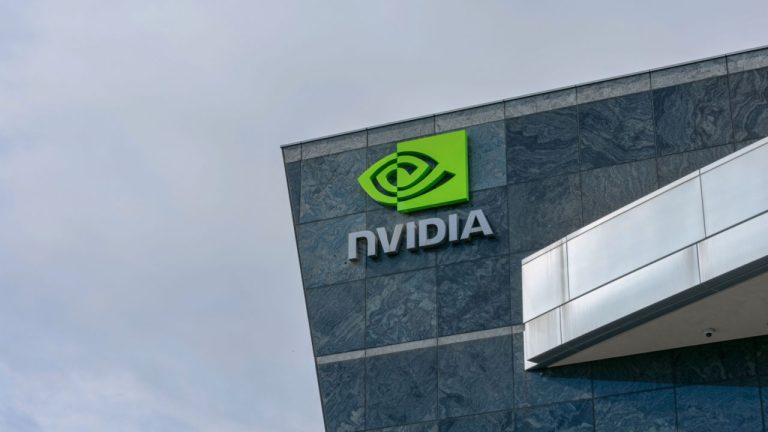
The investor who accurately called the bottom of the bear market late last year is doubling down on his bullish stance on crypto assets. In a lengthy thread, Chris Burniske, former ARK Invest analyst and current partner at venture capital firm Placeholder, tells his 260,400 Twitter followers that the recent artificial intelligence (AI) hype has […]
The post Investor Who Called End of Bear Market Doubles Down on Crypto, Says Industry Undervalued and Overlooked appeared first on The Daily Hodl.

Nvidia share prices have more than tripled since October last year as demand for AI tech surges.
Computer chip manufacturer Nvidia briefly joined the exclusive club of companies with a $1 trillion market capitalization as market demand for artificial intelligence (AI) tech reached a crescendo.
The milestone was hit on May 30 in the United States morning trading hours by the computer chip and graphics card manufacturer with its shares hitting a daily high of over $418 according to Google Finance.
Nvidia shares closed the day at just over $401 and the firm currently has a market cap of $992 million.

In the United States, there are only four companies that have a valuation of more than $1 trillion: Apple, Microsoft, Amazon and Alphabet — Google's parent company.
Nvidia has seen a year-to-date gain of over 180% due to soaring demand for graphics processing units (GPUs) that power generative AI tools.
According to a May 30 Reuters report, analysts said 80% of these GPUs are currently manufactured by Nvidia.
Some may see Nvidia’s recent breakout price action as a sign of an overheated market but other analysts suggest there’s still plenty of room for Nvidia to grow with suggestions that the AI boom may only just be getting started.
"Technical traders and AI mania have pushed Nvidia toward the $1 trillion cap and it is not inexpensive," said Jim Kelleher, an analyst from Argus Research.
Related: Nvidia introduces AI supercomputer to create ChatGPT successors
Nvidia isn’t alone in its quest to bring AI-ready chips to market. Microsoft is reportedly developing its own AI chip to power AI applications for Sam Altman’s artificial intelligence firm OpenAI as well as its own internal projects.
In April, Elon Musk, former CEO of Twitter, purchased thousands of general processing units for an upcoming Twitter AI project according to a source close to the matter.
While tech companies and chip manufacturers in the U.S. are scrambling to get up to speed on everything AI, Chinese developers are finding ways to work around sanctions that banned the latest version of Nvidia chips from being obtained locally.
AI Eye: Make 500% from ChatGPT stock tips? Bard leans left, $100M AI memecoin
 Unlike AI applications such as Chatgpt, cryptocurrencies do not bring “anything useful,” a top executive of U.S. chip maker Nvidia is convinced. The comment comes despite his company making significant sales in the space where its powerful processors are widely used to mint digital coins. Developing Chatbots More Worthwhile Than Crypto Mining, Nvidia Exec Claims […]
Unlike AI applications such as Chatgpt, cryptocurrencies do not bring “anything useful,” a top executive of U.S. chip maker Nvidia is convinced. The comment comes despite his company making significant sales in the space where its powerful processors are widely used to mint digital coins. Developing Chatbots More Worthwhile Than Crypto Mining, Nvidia Exec Claims […]
The chief technology officer (CTO) of US chipmaker Nvidia, Michael Kagan, is skeptical of crypto’s benefit to society, according to a report. Comparing the use of Nvidia’s graphics to mine crypto assets versus powering artificial general intelligence tools such as ChatGPT, The Guardian quotes Kagan as saying that the former has no benefit to society […]
The post Nvidia Top Executive Says Crypto Adds Nothing of Value to Society but AI Does: Report appeared first on The Daily Hodl.
 After dropping below $26,000 per unit, the price of bitcoin, the leading digital asset by market capitalization, is still up 9.6% since last week. However, its price has decreased by 6.5% in the last 24 hours. Out of the 7,316 companies, crypto assets, precious metals, and exchange-traded funds worth more than $82 trillion in value, […]
After dropping below $26,000 per unit, the price of bitcoin, the leading digital asset by market capitalization, is still up 9.6% since last week. However, its price has decreased by 6.5% in the last 24 hours. Out of the 7,316 companies, crypto assets, precious metals, and exchange-traded funds worth more than $82 trillion in value, […] Nvidia, a graphics processing unit and artificial intelligence (AI) company, believes that 2023 could mark the start of a metaverse-driven age in the automotive industry. As part of this new conception, automotive companies will start to include metaverse tech and implement it in their industrial and retail operations. Nvidia Believes Metaverse Tech Will Be Part […]
Nvidia, a graphics processing unit and artificial intelligence (AI) company, believes that 2023 could mark the start of a metaverse-driven age in the automotive industry. As part of this new conception, automotive companies will start to include metaverse tech and implement it in their industrial and retail operations. Nvidia Believes Metaverse Tech Will Be Part […]
Higher volatility, equity offerings and resistance to regulatory sanctions are just a few reasons why investors should keep an eye on BTC.
Let's rewind the tape to the end of 2021 when Bitcoin (BTC) was trading near $47,000, which at the time was 32% lower than the all-time high. During that time, the tech-heavy Nasdaq stock market index held 15,650 points, just 3% below its highest-ever mark.
Comparing the Nasdaq's 75% gain between 2021 and 2022 to Bitcoin's 544% positive move, one could assume that an eventual correction caused by macroeconomic tensions or a major crisis, would lead to Bitcoin’s price being disproportionately impacted than stocks.
Eventually, these “macroeconomic tensions and crises” did occur and Bitcoin price plunging another 57% to $20,250. This shouldn’t be a surprise given that the Nasdaq is down 24.4% as of Sept. 2. Investors also must factor in that the index’s historical 120-day volatility is 40% annualized, versus Bitcoin's 72%, which is roughly 80% higher.
That’s the core reason why investors should re-evaluate investing in Bitcoin. The risk-to-reward potential after the downward adjustment in risk assets possibly leaves more upside for the cryptocurrency considering three factors: higher volatility during a moderate recovery, equity offerings and resistance to regulatory sanctions.
The problem is the market is now in a drawn-out bear trend and there are no signs that point to a quick recovery because double-digit inflation in many countries continues to pressure the central banks to sustain a tighter stance. Notice below how both Bitcoin and the Nasdaq have struggled throughout 2022.

The consequence of raising interest rates and removing debt assets stabilization programs is a recession-like environment. Whether or not a soft landing will be achieved is irrelevant because no sane investor will opt for credit-exposed and growth sectors when the cost of capital is increasing, and consumption is contracting.
Volatility is usually interpreted as negative, considering that the movements in price — either up or down — are accelerated. However, if the investor expects some form of recovery over the next 12 to 36 months, there is no reason to believe that Bitcoin will remain under pressure for that long.
Let's assume a neutral case, such as Bitcoin recovering 25% of the $48,700 drop since the all-time high, while the tech-heavy Nasdaq Index not only recovers the entire 24.4% losses year-to-date in 2022 but adds another 40% gains over that 1 to 3 year period.
That scenario would bring Bitcoin to $32,425, still 53% below its November 2021 all-time high. Thus, for those buying BTC on Sept. 2 at $20,250, that number would represent a 60% profit.
On the other hand, under this neutral market, the Nasdaq would reverse its losses and add 40%, reaching 19,563 points and totaling a 64.4% profit. To be clear: that would be 21.6% higher than the current all-time high.
The top 7 companies on Nasdaq are Apple, Microsoft, Amazon, Tesla, Google, Meta and Nvidia, all well-known tech giants. In stock markets, earnings figures are the most critical metric backing investors' optimism, meaning that higher profits can either be redistributed to shareholders, used to buy back stock or reinvested in the business, itself.
The problem lies when earnings go up, the companies have enormous incentives for issuing more stock, otherwise known as follow-on offers. Moreover, a tech company must constantly acquire emerging niche competitors to secure its leading position. Thus, bull markets create issues of their own, as valuations become too rich and buybacks make little sense.
For Bitcoin, having more miners, investors or infrastructure does not translate to a higher offering because the production schedule has been set from Day 1. The supply is fixed regardless of how the price fluctuates.
Nvidia, a major computer chip and graphics card manufacturer, reached a 68-week low on Sept. 2 after U.S. officials imposed a new license requirement for the company's artificial intelligence chip exports to China and Russia. Meanwhile, in mid-2021, China cracked down on mining facilities in the region, causing Bitcoin's hash rate to drop 50% in 2 months.
The main difference in both cases is Bitcoin's automated difficulty adjustment, which reduces the pressure on miners when there's less activity. While the U.S. regulation will likely impact Nvidia's exports, nothing is stopping Taiwanese TSMC chipmaker, South Korean Samsung or Chinese Huawei from growing and exporting products.
Bitcoin is a digital peer-to-peer electronic cash system, so it doesn't need centralized exchanges to survive. If governments opt to ban crypto trading completely, that would only emphasize the importance and strength of this decentralized network. Multiple countries have tried to suppress foreign currency from circulating, only to create a shadow market, with facilitators acting as illegal intermediaries.
Under the 3 different scenarios, varying from total blockage to a generalized bull market, odds favor Bitcoin against tech stocks at the current prices. Consequently, adjusted for its volatility, the risk reward strongly favors the cryptocurrency.
The views and opinions expressed here are solely those of the author and do not necessarily reflect the views of Cointelegraph. Every investment and trading move involves risk. You should conduct your own research when making a decision.

Nvidia's CFO said falling crypto prices and changes in consensus mechanisms have in the past impacted demand for its products and the company's ability to estimate it.
Graphics card giant Nvidia CFO Colette Kress says the company has been unable to estimate reduced crypto mining demand impacted its Q2 results, which fell short of analyst expectations on Wednesday.
The chip giant released its financial results for the three months ended Jul. 31y, which revealed a 19% quarter-on-quarter drop in revenue to $6.5 billion, while net income fell 59% to $656 million.
Revenue for its gaming division, which includes sales of its high-end GPUs, fell 44% in revenue from the previous quarter to $2.04 billion, which Nvidia attributed to “challenging market conditions.”
Kress, who also serves as executive vice president of the company, said Nvidia has limited visibility on how the crypto market affects the demand for their gaming products:
"Our GPUs are capable of cryptocurrency mining, though we have limited visibility into how much this impacts our overall GPU demand.”
“We are unable to accurately quantify the extent to which reduced cryptocurrency mining contributed to the decline in Gaming demand,” she added.
While the chip giant’s graphic processing units (GPUs) were designed for gaming purposes, high demand for crypto mining activities over the past few years has contributed to a 320% increase in the company’s share price over the last five years.
Kress said, however, that falling crypto prices and changes in consensus mechanism have in the past impacted demand for its products and the ability to estimate it.
“Volatility in the cryptocurrency market – such as declines in cryptocurrency prices or changes in method of verifying transactions, including proof of work or proof of stake — has in the past impacted, and can in the future impact, demand for our products and our ability to accurately estimate it.”
With the Ethereum Merge scheduled for Sep. 15, the network’s consensus change to proof-of-stake (PoS) could further drive down the demand for crypto mining hardware. This could spell trouble for cryptocurrency mining products such as Nvidia’s CMP170 HX which currently costs around $4,695.
Related: Nvidia to pay $5.5M as part of SEC case concerning 'inadequate disclosures' around crypto mining
That being said, cryptocurrencies such as Bitcoin, Litecoin, Monero, and Dogecoin are among the networks still operating on proof-of-work consensus mechanisms with no observable plans to transition in the future.
Nvidia’s share price has also dropped 5.89% over the last 5 days on the NASDAQ.

Derivatives data show a clear path to $29,000, but inflation and unemployment data will continue to be crucial to determining BTC price rallies.
Bitcoin (BTC) price continues to battle at the $24,000 resistance and the price was rejected there on Aug. 10, but the rejection was not enough to knock the price out of the 52-day-long ascending channel. The channel has a $22,500 support and this bullish formation suggests that the BTC price will eventually hit the $29,000 level by early October.

Bitcoin derivatives data does show a lack of interest from leveraged longs (bulls), but at the same time, it does not price higher odds of a surprise crash. Curiously, the most recent Bitcoin downturn on Aug. 9 was accompanied by a negative performance from U.S.-listed stocks.
On Aug. 8, chip and video graphics card maker Nvidia Corp (NVDA) announced that its 2Q sales would present a 19% drop compared to the previous quarter. Moreover, the U.S. Senate passed a bill on Aug. 6 that could negatively impact corporate earnings. Despite freeing $430 billion to fund "climate, healthcare and tax," the provision would impose a 1% tax on the stock buyback by publicly traded companies.
The high correlation of traditional assets to cryptocurrencies remains a huge concern for some investors. Investors should not be getting ahead of themselves even if inflationary pressure recedes because the U.S. Fed monitors employment data very closely. The latest reading displayed a 3.5% unemployment typical of overly heated markets, forcing the monetary authority to keep raising interest rates and revoking stimulus debt purchase programs.
Reducing risk positions should be the norm until investors clearly indicate that the U.S. Central Bank is closer to easing the tighter monetary policies. That is precisely why crypto traders are following macroeconomic numbers so closely.
Currently, Bitcoin lacks the strength to break the $24,000 resistance, but traders should study derivatives to gauge professional investors' sentiment.
The Bitcoin futures annualized premium measures the difference between longer-term futures contracts and the current spot market levels. The indicator should run between 4% to 8% to compensate traders for "locking in" the money until the contract expiry. Thus, levels below 2% are extremely bearish, while the numbers above 10% indicate excessive optimism.

The above chart shows that this metric dipped below 4% on June 1, reflecting traders' lack of demand for leverage long (bull) positions. However, the present 2% reading is not particularly concerning, given that BTC is down 51% year-to-date.
To exclude externalities specific to the futures instrument, traders must also analyze Bitcoin options markets. The 25% delta skew is a telling sign whenever arbitrage desks and market makers overcharge for upside or downside protection.
Related: Bitcoin price sees $24K, Ethereum hits 2-month high as US inflation shrinks
If those traders fear a Bitcoin price crash, the skew indicator will move above 12%. On the other hand, generalized excitement reflects a negative 12% skew.

Data shows that the skew indicator has been ranging between 3% and 5% since Aug. 5, which is deemed to be a neutral area. Options traders are no longer overcharging for downside protection, meaning they might lack excitement, but at least they have abandoned the "fear" sentiment seen in the last few months.
Considering Bitcoin's current ascending channel pattern, Bitcoin investors probably should not worry too much about the lack of buying demand, according to futures market data.
Of course, there is healthy skepticism reflected in derivatives metrics, but the path to a $29,000 BTC price remains clear as long as inflation and employment statistics are under control.
The views and opinions expressed here are solely those of the author and do not necessarily reflect the views of Cointelegraph. Every investment and trading move involves risk. You should conduct your own research when making a decision

The Nvidia Omniverse is launching a series of new tools for creators and developers in digital worlds to make life in the metaverse more realistic.
Hardware maker Nvidia is ramping up its efforts to make a stand in the Metaverse. On Tuesday, the company revealed a new set of developer tools focused on metaverse environments, including new AI capabilities, simulations, and other creative assets.
Creators utilizing the Omniverse Kit, along with apps such as Nucleus, Audio2Face and Machinima, will be able to access the new upgrades. Nvidia says one primary function of the tools will be to help enhance building "accurate digital twins and realistic avatars."
Quality of metaverse interaction is a hot topic in the industry, as developers and users ponder the quality of experiences over the quantity. One example of this could be seen during the first-ever metaverse fashion week, which happened in spring.
Overwhelmingly stated in the feedback of the event was the lack of quality in the digital environments, garments, and particularly the avatars with which people interacted.
The new Nvidia toolkit includes the Omniverse Avatar Cloud Engine (ACE). The developers claim that ACE will improve building conditions of “virtual assistants and digital humans.”
“With Omniverse ACE, developers can build, configure and deploy their avatar applications across nearly any engine, in any public or private cloud.”
Digital identity is a key focus of the update in the Audio2Face application. The official statement from Nvidia says users can now direct the emotion of digital avatars over time, including full-face animation.
It’s clear that engagement in the metaverse will continue to develop. In fact, the metaverse market share should surpass $50 billion in the next four years, signaling an increase in participation. Moreover, new events, workplaces, and even university classes are popping up in digital reality.
Therefore, more users will seek to create digital versions of themselves. The development of technology to support mass metaverse adoption is crucial.
Related: Digital identity in the Metaverse will be represented by avatars with utility
Another addition to the Nvidia update includes Nvidia PhysX, which is an "advanced real-time engine for simulating realistic physics." This means developers can include realistic reactions to metaverse interactions that obey the laws of physics.
NVIDIA’s AI technology has been an important element in creating spaces for social interaction in the digital universe thus far. Even more so now, as it rolls out new applications for developers to enhance the metaverse.